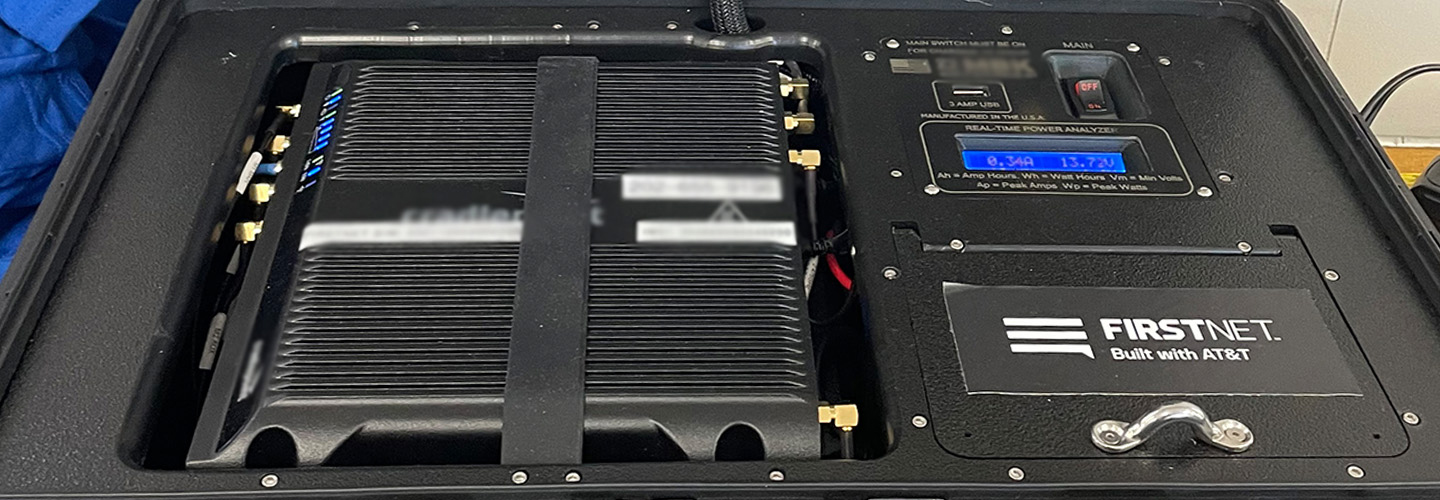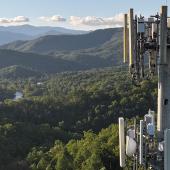Today’s firefighters must maintain connectivity, whether the mission takes them into remote wilderness areas or dense urban buildings. These places can be at the edges of where networks reach. By boosting signal strength, high-power user equipment on FirstNet helps firefighters stay connected wherever the call takes them.
HPUE boosts signal strength
High-power user equipment, or HPUE, transforms the way we approach coverage at the outer reaches of a cell site.
HPUE works by boosting signal strength up to six times the normal cellular power to maximize the network’s coverage area. It can improve connectivity and uplink data speeds—particularly at the edge of signal coverage—to keep first responders communicating. The technology gives public safety devices the power to punch through and maintain connection to the network when traditional devices might slow or drop off entirely.
I sometimes compare HPUE to what a mobile repeater does for radios. When I was in the fire service, we used mobile repeaters to get coverage in areas where our radios didn't work. The extra power from the HPUE is like boosting the power in my mobile radio, which eliminates the need for a repeater in the field.
Developed for public safety
This technology is designed for the fire service and other first responders on FirstNet. The network’s Band 14 spectrum is the only band in the United States operating with HPUE.
The FirstNet Authority worked with regulators and standards bodies to ensure that first responders got access to this important technology. HPUE is built to mission-critical standards developed by the 3rd Generation Partnership Project, or 3GPP.
HPUE transmits stronger signals by using Band 14 spectrum and specially designed FirstNet modems. The modems also operate on other AT&T bands at standard power levels. With HPUE’s increased signal, first responders get an enhanced experience with better range, coverage, penetration, and capacity for their devices.
FirstNet’s HPUE options
FirstNet’s HPUE product is called FirstNet MegaRange™ . MegaRange has three device options, for use in vehicles, on-the-go, or at fixed locations.
- MegaMobile is designed to be used in vehicles such as a fire apparatus. It can support connectivity on land, on water, or wherever the mission goes.
- MegaGo is for use on-the-go, so firefighters can take FirstNet MegaRange with them. This portable HPUE device comes in a rugged waterproof carrying case with a rechargeable battery pack, Wi-Fi hot spot, and integrated antennas.
- MegaFixed is for fixed use to boost FirstNet in remote sites, command centers, and IoT applications. It has HPUE technology plus an ethernet injector and a wall adapter for AC power sources.
These devices are on the National Institute of Standards and Technology (NIST) list of devices that are certified for use on FirstNet. To be certified for the NIST list, devices are subjected to a battery of tests by federal researchers to ensure that they meet the unique needs of first responders.
Urban coverage in hard-to-reach spots
In urban environments, MegaRange can improve connectivity where signal penetration is hindered by dense urban surroundings or in underground locations.
The stronger signal helps urban firefighters better communicate in both indoor and outdoor locations. HPUE boosts coverage in hard-to-reach spots like tunnels, basements, elevators, stairwells, parking garages, and building shadows.
Remote coverage at the network’s edge
In remote environments, connectivity is improved at the edge of the network’s typical signal. HPUE can be particularly helpful for the fire service when fighting wildland fires, going on maritime missions, conducting remote search and rescue, or operating in rural areas.
In the rural Finger Lakes region of New York state, the famous gorges, hills, and forest land have made communications challenging for Bangs Ambulance. Prior to FirstNet, agency officials said they had about 60% coverage for the mileage they traveled. When they switched to FirstNet, that coverage increased greatly. With FirstNet MegaRange’s stronger signals, they report almost 100% coverage.
“We provide services in areas with challenging terrain. With FirstNet MegaRange, our paramedics were incredibly impressed with the improved coverage,” said Brad Marzolf, Director of Information Services and Compliance Officer for Bangs Ambulance.
Improving uplink speeds
HPUE works well for fire service tasks with demanding uplink data speeds, like video streaming. Public-safety officials in Texas have successfully improved data speed and range using HPUE.
“With FirstNet MegaRange, we noticed a substantial coverage improvement in some remote areas, and we sustained high data speeds even as we moved further away from wireless towers,” said Jared Vandenheuvel, program coordinator with the Texas Department of Public Safety. “This will be especially advantageous for public safety and first responders who have high uplink needs, such as drone teams sending video back to operations centers.”
To learn more about how FirstNet is helping public safety and the Fire Services community to leverage innovative public safety communications, sign up for the Fire Services newsletter.




















